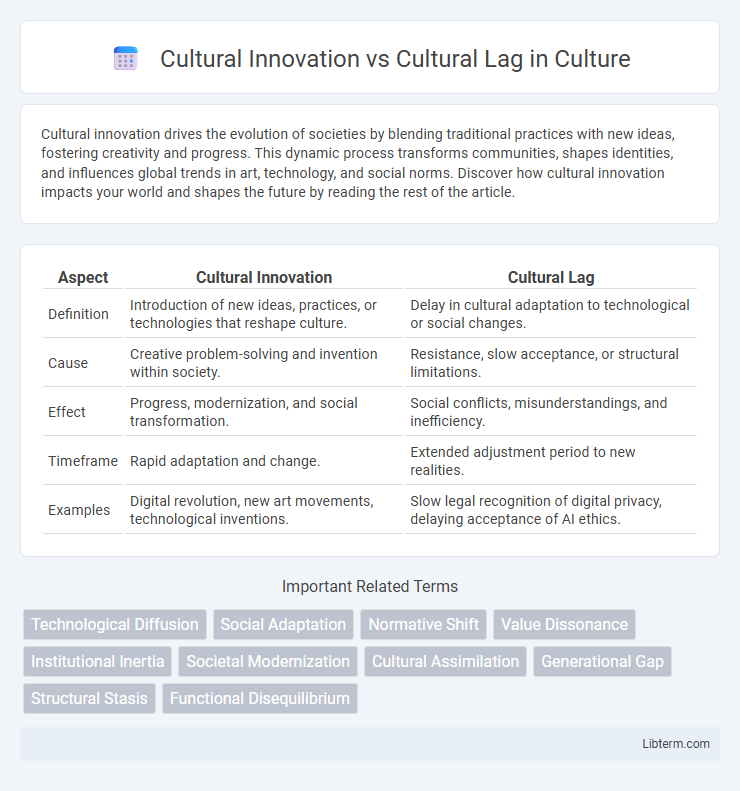Cultural innovation drives the evolution of societies by blending traditional practices with new ideas, fostering creativity and progress. This dynamic process transforms communities, shapes identities, and influences global trends in art, technology, and social norms. Discover how cultural innovation impacts your world and shapes the future by reading the rest of the article.
Table of Comparison
| Aspect | Cultural Innovation | Cultural Lag |
|---|---|---|
| Definition | Introduction of new ideas, practices, or technologies that reshape culture. | Delay in cultural adaptation to technological or social changes. |
| Cause | Creative problem-solving and invention within society. | Resistance, slow acceptance, or structural limitations. |
| Effect | Progress, modernization, and social transformation. | Social conflicts, misunderstandings, and inefficiency. |
| Timeframe | Rapid adaptation and change. | Extended adjustment period to new realities. |
| Examples | Digital revolution, new art movements, technological inventions. | Slow legal recognition of digital privacy, delaying acceptance of AI ethics. |
Defining Cultural Innovation
Cultural innovation refers to the introduction and adoption of new ideas, practices, or technologies within a society that significantly alter its cultural landscape. It drives social progress by promoting adaptation and enhancing cultural complexity. Understanding cultural innovation is essential to analyzing how societies evolve and respond to changing environmental and technological conditions.
Understanding Cultural Lag
Cultural lag occurs when non-material culture, such as beliefs or social norms, fails to keep pace with material culture like technology or infrastructure, leading to social conflicts or disruptions. Understanding cultural lag helps explain resistance to change and the challenges societies face adapting to rapid technological advancements. Sociologist William F. Ogburn's theory highlights how cultural lag influences the gap between innovation adoption and cultural acceptance.
The Relationship Between Innovation and Lag
Cultural innovation drives societal advancement through the rapid introduction of new ideas, technologies, and practices, while cultural lag occurs when social norms and institutions fail to keep pace with these changes. The relationship between innovation and lag highlights a temporal gap where material culture evolves faster than non-material culture, causing social disruption and adjustment challenges. Addressing this imbalance is crucial for harmonizing technological progress with evolving values and behaviors.
Historical Examples of Cultural Innovation
Historical examples of cultural innovation include the Renaissance period, which introduced revolutionary advancements in art, science, and philosophy, transforming European society. The invention of the printing press by Johannes Gutenberg in the 15th century accelerated the spread of knowledge and literacy, reshaping cultural norms and education systems. The Industrial Revolution also exemplifies cultural innovation, as technological breakthroughs in manufacturing and transportation drastically altered social structures and economic practices worldwide.
Instances of Cultural Lag Across Societies
Instances of cultural lag are evident when technological advancements in societies outpace the development of related social norms and regulations, such as the rise of social media platforms before comprehensive privacy laws were established. In many developing countries, rapid industrialization created cultural lag by introducing modern machinery without corresponding shifts in labor rights or environmental policies. Historical examples include the spread of smartphones in rural communities where educational systems and infrastructure have yet to adapt, leading to a gap between technological use and cultural integration.
Factors Driving Cultural Innovation
Technological advancements and globalization are primary factors driving cultural innovation by enabling rapid exchange of ideas and fostering cross-cultural interactions. Economic development and changes in social values also accelerate cultural innovation by creating new consumer needs and shifting societal norms. Institutional support through education and media further promotes cultural innovation by disseminating knowledge and encouraging creativity.
Causes and Consequences of Cultural Lag
Cultural lag occurs when material culture, such as technology and infrastructure, advances faster than non-material culture, including laws, beliefs, and values, creating a gap that causes social conflicts and adaptation difficulties. Causes of cultural lag include technological breakthroughs outpacing regulatory frameworks, resistance to change within institutions, and slow shifts in public attitudes and norms. Consequences often involve social unrest, inequality, and inefficiencies, as society struggles to integrate innovations with existing cultural structures and ethical considerations.
Bridging the Gap: Overcoming Cultural Lag
Bridging the gap between cultural innovation and cultural lag requires proactive adaptation of social norms and institutions to emerging technologies and ideas. Strategies include fostering inclusive education, promoting open dialogue across generations, and implementing flexible policies that respond swiftly to cultural shifts. These efforts help synchronize societal values with technological advancements, minimizing resistance and enabling smoother integration of innovation.
The Role of Technology in Cultural Change
Technology acts as a catalyst for cultural innovation by introducing new tools, communication methods, and social practices that reshape societal norms and values. Cultural lag occurs when social institutions and behaviors struggle to adapt to rapid technological advancements, creating a gap between innovation and cultural acceptance. Understanding the balance between technological progress and cultural adaptation is essential for managing social change and promoting sustainable development.
Future Implications for Cultural Adaptation
Cultural innovation drives rapid technological, social, and ideological changes that shape future societal norms, while cultural lag occurs when social institutions struggle to adapt to these changes, creating tension and resistance. Understanding and addressing cultural lag is crucial for smooth cultural adaptation, as failing to update legal, educational, and ethical frameworks may hinder progress and exacerbate inequalities. Fostering flexible cultural systems and proactive policy-making enables societies to harness innovation's benefits while minimizing disruption and ensuring sustainable development.
Cultural Innovation Infographic

 libterm.com
libterm.com